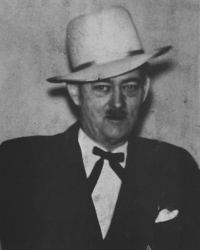History
About Us
Calendar
Gallery
Events
Artists
Links
People
History
Contact
Rent
Join
News
Victor R. Small

Victor Roy Small was born in Kentucky in 1888, the oldest child of John Abraham Small and Hattie Overholser Small. The family then moved to Brookville, OH, where he was raised. He taught school for several years but decided to become a physician. After completing pre-med studies at Miami University in Oxford, Ohio, he then attended medical school at Ohio State University in Columbus, Ohio, and was licensed to practice in 1916. Dr. Small then served two years (1917-1919) on the front lines in France during WWI, where he met his wife, Susanne C. Jacobs, a Red Cross nurse. Susanne (1888-1965) was a native of Council Bluffs, Iowa. They were married in 1920.
After the war, Dr. Small became interested in mental health. Following a short term on the medical staff at the Galipolis State Hospital in Galipolis, Ohio, he spent his life in North Carolina, first in Raleigh at the Dorothea Dix State Mental Hospital and later in Clinton, where he moved in 1923 to establish his own medical practice.
Doc and Susanne had one child, a daughter, Patricia Ann “Pat” Small (1921-1962). Pat died of a heart attack in Kansas City, Missouri, where she worked as a dress designer. She had married but had no children.
Dr. Small was a creative person, well read with a great love for the arts. Before attending medical school, he worked in the harvest fields of the Dakotas where he learned the feel of rich earth in his hands and the emotions of the open lands, the wide sky. He wrote and had published five books, four of them poetry: “The Feel of the Earth”, “Over My Shoulder”, “Down Coharie River Way”, and “Old Footprints in the Clay”. His novel, “I Knew 3,000 Lunatics”, based on his time spent as a physician in Galiopolis State Mental Hospital, was later made into a stage play called “All the Living”. He owned a small cabin overlooking the Black River in lower Sampson, where he would often go alone to write poetry or simply to enjoy the serenity of the flowing waters.
In Clinton Dr. Small made his home in a large Classic Revival-style house located at 709 College Street. He purchased the house and lot in 1924 from Mrs. Bettie S. Matthews, the widow of the late Leamon L. Matthews. Mr. Matthews had been the Superintendent of the Sampson County Schools. He had purchased the house in 1908 from Judge Henry A. Grady. Before that, Abram Hobbs had purchased the lot in 1869 from the Reverend Jonathan L. Stewart, who had come to Clinton during the War Between the States from Mississippi. It is thought that the house was built about 1870 by Abram Hobbs, but some records indicate that it may have been built as early as 1854. It was remodeled beyond recognition in 1908 and then again in 1925 by Dr. Small.
A distinguishing characteristic of the house includes a tall, two-story portico that shelters a small, central balcony; pillared porches flank each side with four square columns. Interior treatments feature massive doors and windows and a fine paneled staircase is located at the rear end of the hall. There are four large rooms downstairs and four upstairs with halls on both floors. The exterior is weather boarded with heart timbers and the floors are also of heart pine. Adjacent to the west end of the house was his doctor’s office, a smaller building of similar design that Dr. Small had added. A child’s playhouse located in the backyard is in some aspects a replica of the larger house.
The house is located on a large spacious lot with beautiful oaks, magnolias, and pecan trees. In days past many of its trees were draped in massive wisteria vines, and there are still remnants of an earlier garden. At one time it was part of a large farm owned by Abram Hobbs that included numerous barns and outbuildings. The pecan trees were part of a large grove that still survives today, the fruits of which are still enjoyed throughout the neighborhood.
Dr. Small, or “Doc” as he was affectionately known, was a beloved physician who made house calls and had great compassion for the poor. His principal purpose in the practice of medicine was not for material gain but to be of service to mankind. He often joked about hypochondriacs and recommended that they get plenty of exercise, drink plenty of water, and develop a hobby.
Dr. Small was very concerned about the decline of interest in the fine arts and decided to do something about it. In his Last Will and Testament, he left his College Street home and property to Sampson County to be used “primarily as an archives repository for collected, and to be collected articles, papers, and other memorabilia; and also for the use of certain persons or groups of persons, who from time to time wish to use the buildings for the purpose of promoting and furthering an interest in music, literature, and the fine arts in general”. After his death in early 1971, his house was given to the county to be maintained as a museum or cultural center, and today it is under the care of the Sampson County Arts Council. The will further stipulated that the property and its furnishings were to be left intact, insofar as possible. One humorous directive by Dr. Small was that his old bathtub be kept, as he explained: “My reasons are sentimental, since I have bathed, sang, and even written poetry while bathing in it”. As a result of his gift to the county, the Small House is the home of the Sampson Arts Council and is used primarily as the benefactor wanted it to be. The house is furnished with his belongings with some refurbishing by local volunteers and civic organizations. The property is on the National Registry of Homes and Buildings.
